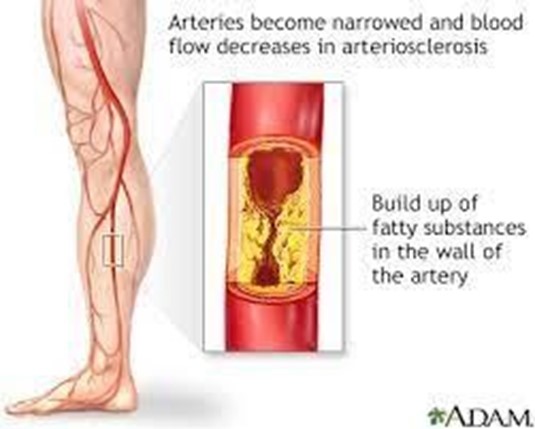When assessing Mrs. Bradshaw, the nurse documents the left femoral pulse as 0/0-4+. Which of the following findings would the nurse expect at the left dorsalis pedialis pulse?
2+/0-4+
3+/0-4+
1+/0-4+
0/0-4+
The Correct Answer is D
a. Incorrect
This choice suggests a left dorsalis pedis pulse of 2+/0-4+. However, since the left femoral pulse was documented as 0/0-4+, indicating no pulse, it is not expected for a pulse to be present in the left dorsalis pedis. Therefore, this choice is incorrect.
b. Incorrect
This choice suggests a left dorsalis pedis pulse of 3+/0-4+. Again, since the left femoral pulse was documented as 0/0-4+, indicating no pulse, it is not expected for a pulse to be present in the left dorsalis pedis. Therefore, this choice is incorrect.
c. Incorrect
This choice suggests a left dorsalis pedis pulse of 1+/0-4+. However, as mentioned earlier, the left femoral pulse was documented as 0/0-4+, indicating no pulse. Therefore, it is not expected for a pulse to be present in the left dorsalis pedis. This choice is incorrect.
d. Correct
This choice suggests a left dorsalis pedis pulse of 0/0-4+. Since the left femoral pulse was documented as 0/0-4+, indicating no pulse, it is expected that the left dorsalis pedis pulse will also be absent or diminished. Therefore, this choice is correct.
Nursing Test Bank
Naxlex Comprehensive Predictor Exams
Related Questions
Correct Answer is B
Explanation
a. Incorrect
Ischemia caused by a complete blockage of an artery supplying the left leg would typically result in constant pain, even at rest. The fact that the pain disappears after resting for a few minutes suggests that the blood flow is temporarily restored.
Therefore, this choice is incorrect.
b. Correct
The description of pain in the left calf when exercising, which disappears after resting for a few minutes, is most consistent with claudication caused by partial blockage of an artery supplying the left leg. During exercise, the demand for oxygen-rich blood
increases, but the narrowed or partially blocked artery is unable to supply enough blood, leading to ischemia and resulting pain. Resting allows the oxygen supply to catch up, relieving the pain. This is a characteristic feature of claudication, which is commonly associated with peripheral arterial disease (PAD).
c. Incorrect
Claudication is not due to venous abnormalities in the left leg but rather arterial insufficiency. Venous abnormalities may result in symptoms such as swelling,
discoloration, or a heavy, achy sensation, but not the pain associated with exercise and subsequent relief after rest. Therefore, this choice is incorrect.
d. Incorrect
Venous obstruction of the left leg would typically present with different symptoms, such as swelling, discoloration, or pain that worsens with prolonged standing or
sitting. The pattern of pain during exercise and relief after rest is not consistent with venous obstruction. Therefore, this choice is incorrect.
Correct Answer is B
Explanation
a. Incorrect
Sore muscles typically result from overexertion or physical activity and are not typically associated with pain that specifically occurs during climbing stairs and is relieved by resting. The described pattern of pain and relief does not align with sore muscles. Therefore, this choice is incorrect.
b. Correct
The description of pain in the left calf during stair climbing, which is relieved by sitting for a few minutes, is most consistent with claudication. Claudication refers to pain or cramping in the muscles, often in the calf, that occurs with exercise or activity and is relieved by rest. It is commonly caused by decreased blood flow due to arterial narrowing or blockage, typically seen in peripheral arterial disease (PAD). The symptoms described by Paul Simon align with the classic features of claudication. Therefore, this choice is correct.
c. Incorrect
Rationale: Venous insufficiency typically presents with symptoms such as swelling, discoloration, or a heavy, achy sensation in the legs. It is not typically associated with pain during specific activities like climbing stairs. The described symptoms are not indicative of venous insufficiency. Therefore, this choice is incorrect.
d. Incorrect
Rationale: Muscle cramps are characterized by sudden and involuntary contractions of a muscle. While muscle cramps can occur during physical activity, they are not typically relieved by sitting and resting for a few minutes. The described pattern of pain and relief is not consistent with muscle cramps. Therefore, this choice is
incorrect.

Whether you are a student looking to ace your exams or a practicing nurse seeking to enhance your expertise , our nursing education contents will empower you with the confidence and competence to make a difference in the lives of patients and become a respected leader in the healthcare field.
Visit Naxlex, invest in your future and unlock endless possibilities with our unparalleled nursing education contents today
Report Wrong Answer on the Current Question
Do you disagree with the answer? If yes, what is your expected answer? Explain.
Kindly be descriptive with the issue you are facing.
